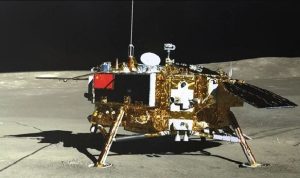04-05-2024
BEIJING: China has launched a probe to collect samples from the far side of the Moon, in what is being billed a world first.
An unmanned rocket carrying the Chang’e-6 probe blasted off from the Wenchang Space Launch Center at about 17:27 local time (10:27 BST).
 The 53-day mission aims to bring around two kilograms of lunar samples to Earth for analysis.
The 53-day mission aims to bring around two kilograms of lunar samples to Earth for analysis.
It will try to re-launch from the side of the moon facing away from Earth.
This is described as the dark side of the Moon because it is invisible from Earth, not because it does not catch the sun’s rays.
It has a thicker, older crust with more craters, which are less covered by ancient lava flows than the near side.
This may make it more possible to collect material that helps shed light on how the Moon was formed, scientists hope.
Ge Ping, vice director of China’s Lunar Exploration and Space Engineering Center, told reporters ahead of the launch: “Chang’e-6 will collect samples from the far side of the Moon for the first time.”
The probe was named after the Moon goddess and one of the most popular figures in Chinese mythology.
It is expected to land in the South Pole-Aitken Basin, which is some 2,500km (1,553 miles) wide and up to 8km (5 miles) deep.
It then aims to collect lunar soil and rocks, and conduct experiments.
The launch marks the first of three high-wire unmanned missions to the moon planned by China this decade.
 Chang’e-7 will search the lunar South Pole for water, and Chang’e-8 will attempt to establish the technical feasibility of building a planned base, known as the International Lunar Research Station.
Chang’e-7 will search the lunar South Pole for water, and Chang’e-8 will attempt to establish the technical feasibility of building a planned base, known as the International Lunar Research Station.
Its predecessor, Chang’e-5, retrieved the youngest ever lavas from the Moon on its return in December 2020. Friday’s lift off marks the latest stage in China’s space exploration program that is competing with the US.
Five years ago China became the first country to land a rover on the Moon’s far side.
By 2030, it aims to have put its first astronauts on the Moon, and to have sent probes to collect samples from Mars and Jupiter.
China is a relative late-bloomer when it comes to the world of space exploration but just 15 years after it first sent an astronaut into orbit, China has become the first country to successfully land a robotic spacecraft on the far side of the Moon and in the next decades it plans not only to build a new space station, but also a base on the Moon and conduct missions to Mars.
Importantly, Xi Jinping, the country’s most powerful leader since Chairman Mao, has thrown his support behind the “space dream” and with it billions in investment. Chinese state media, meanwhile, have cast the “space dream” as one step in the path to “national rejuvenation”.
According to Prof Keith Hayward, a fellow of the UK’s Royal Aeronautical Society, China is being driven by the same motivations as the US, Russia and others.
First, demand from the military, without which “you would not have had half the money going in”.
Second, as “a good way to show off”. “You could say that this is the space Silk Road it demonstrates China is a force to be reckoned with,” Prof Hayward notes.
Third, hitherto untapped resources which have the potential to make whoever finds them wealthy. (Int’l Monitoring Desk)
 Pressmediaofindia
Pressmediaofindia




